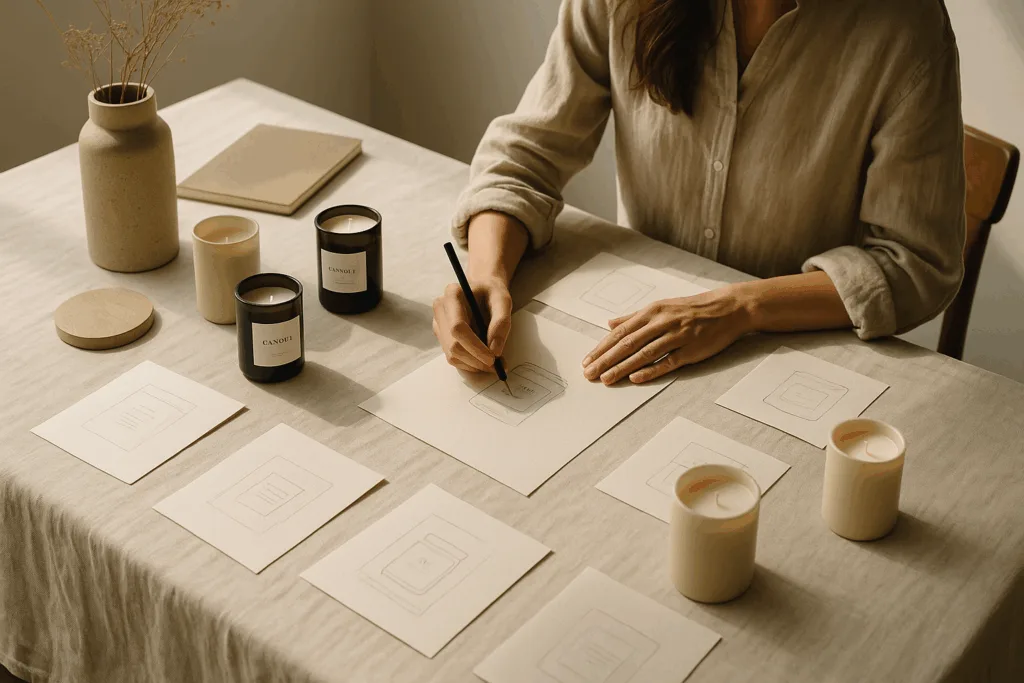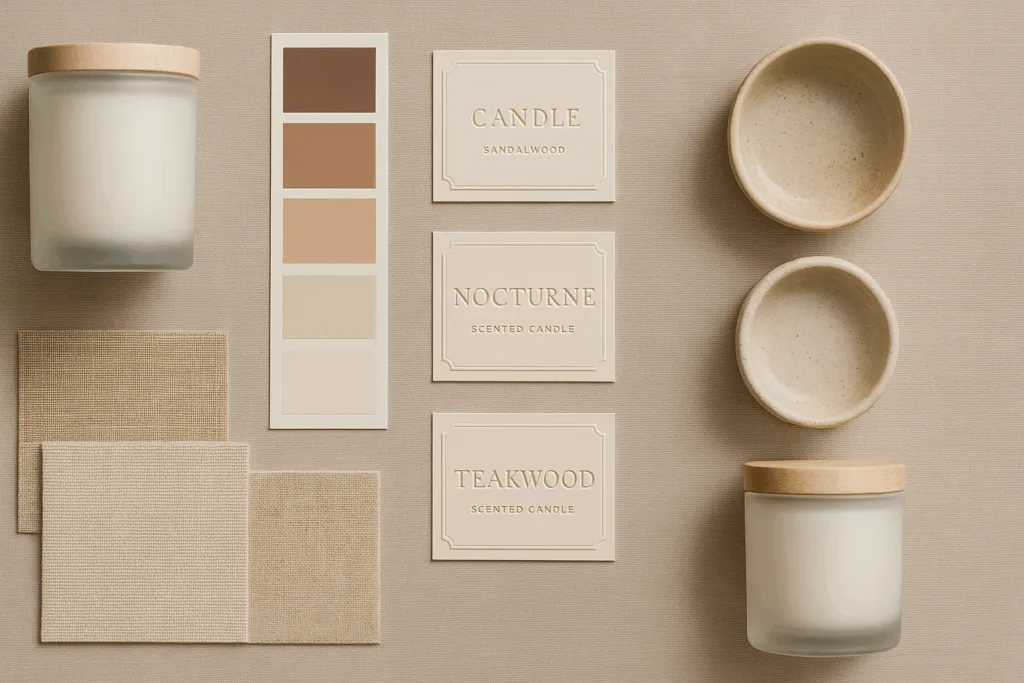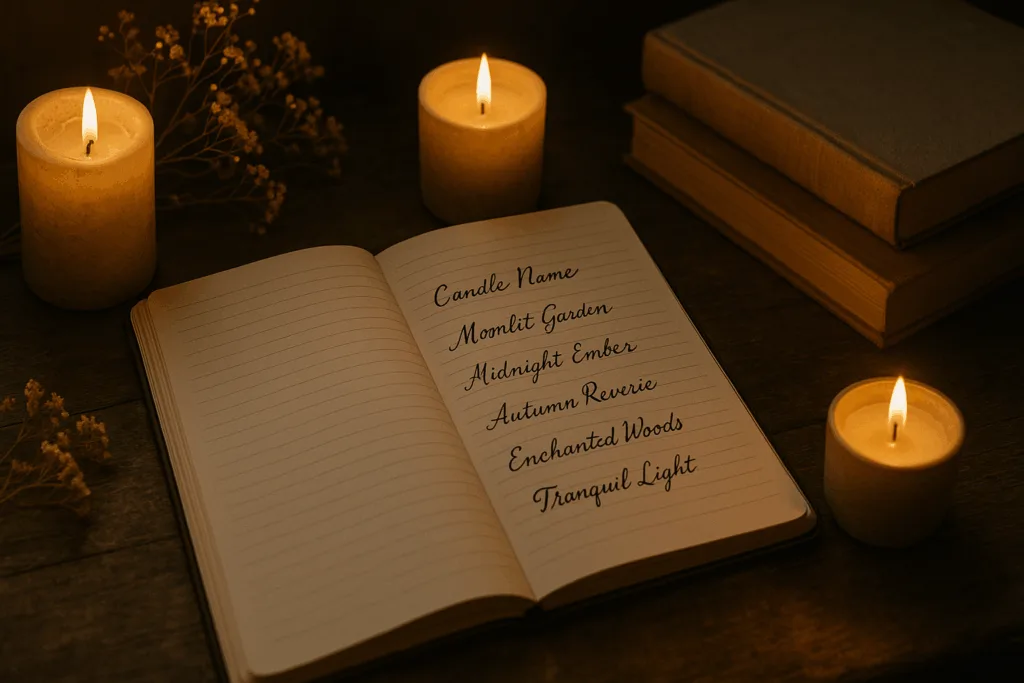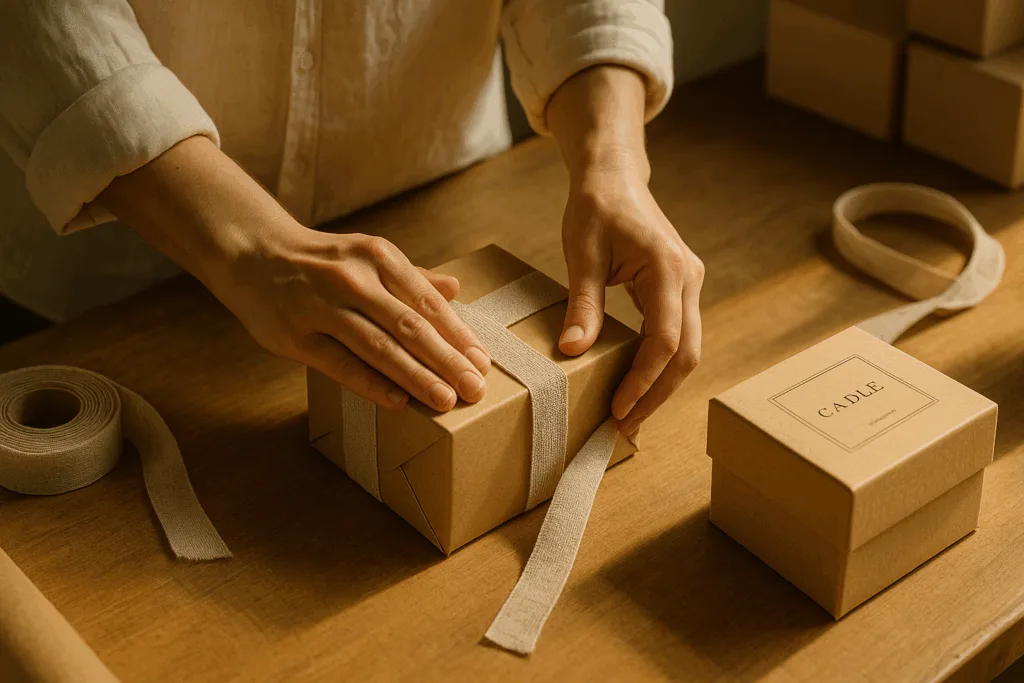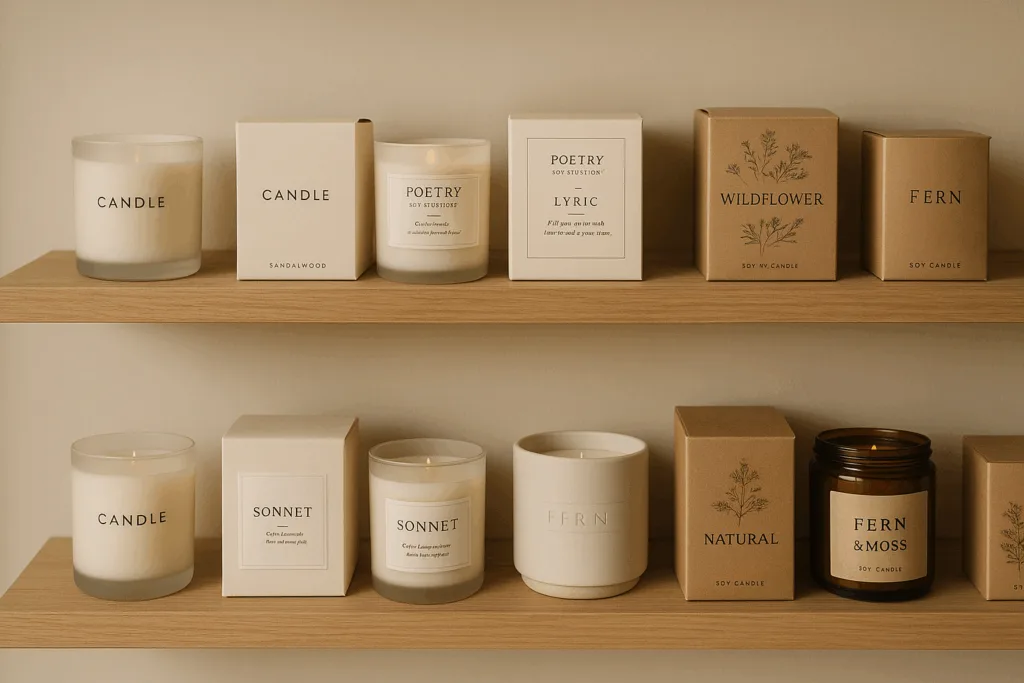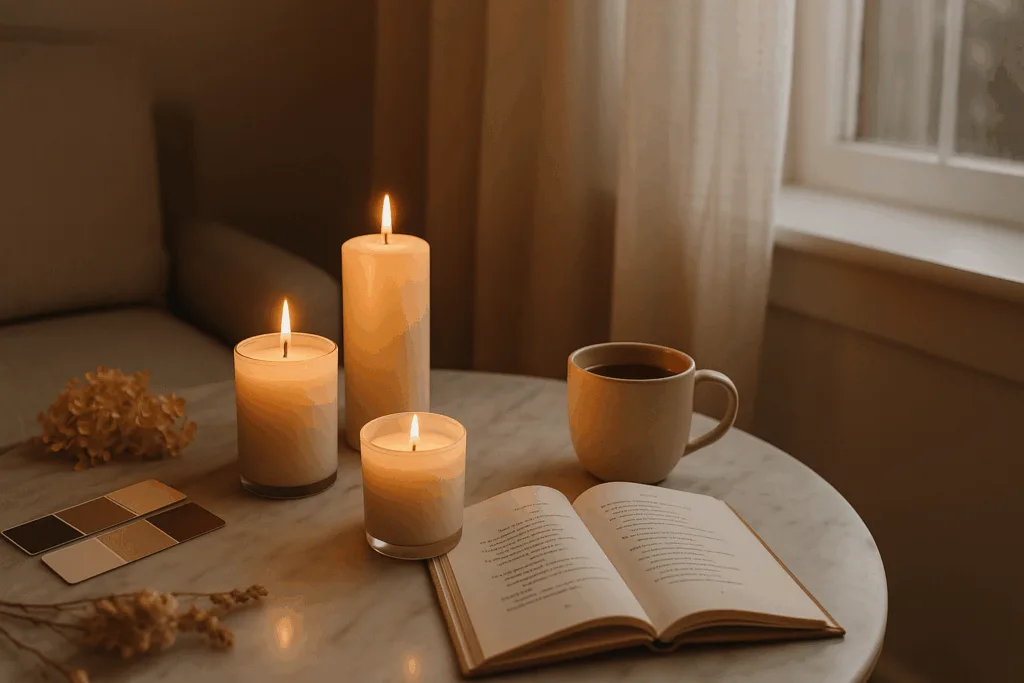Introduction: Design as the Language of Candle Creation
Every candle brand begins with a story—a spark of inspiration seeking form, scent, and identity. Before the first wick is trimmed or the first fragrance blended, a question emerges: What does this candle mean? In a market where scent families can be duplicated and wax formulas shared, the defining power lies not in the ingredients, but in design.
Design is more than packaging; it is the narrative architecture of a brand. It speaks before words do, whispers before the candle is lit, and lingers long after the flame is gone. For emerging brands, design is the bridge between imagination and perception, transforming a product into a sensory experience.
This article explores how to start your candle brand by focusing on design—not merely as aesthetic decoration but as an act of storytelling. We delve into visual and literary branding: how a poetic idea becomes scent, texture, and light; how narrative becomes fragrance; and how form communicates philosophy.
Why Every Candle Brand Begins with Design
Before your candle burns, its design must already speak. Every jar, font, and texture serves as a first impression, shaping how customers perceive value, emotion, and identity. The best brands understand that design is not an afterthought—it is the first layer of storytelling.
Design translates intangible qualities into tangible forms:
- Visual Identity: The colors, shapes, and textures that express personality.
- Emotional Resonance: How aesthetics mirror the brand’s values—calm, passion, nostalgia, or luxury.
- Memorability: A signature style that ensures customers remember and return.
In candle branding, visual design is the scent before the scent—the moment a customer feels something before fragrance even enters the air.
Global Candle Market and the Rise of Aesthetic Consciousness
The modern candle market has evolved far beyond simple function. With global sales surpassing $10 billion annually, candles have become symbols of self-expression, design, and mindfulness. Consumers seek products that reflect their inner world—their aesthetics, values, and rituals.
This shift toward design-centric purchasing behavior has fueled the rise of artisanal candle brands that embody literary elegance, minimalism, and sustainability. Where mass-market brands sell utility, independent makers sell meaning. Each vessel becomes an object of décor, and each scent a line in a sensory poem.
The Rise of Literary Candle Brands
The idea of literary branding—drawing inspiration from poetry, mythology, and philosophy—has redefined modern luxury. Candles now tell stories: of seasons, emotions, or forgotten moments. Names like Sea Library, Golden Hour, or Letters from Home are not just product titles but fragments of literature in wax form.
This storytelling approach builds emotional depth. It elevates candles from consumer goods to cultural artifacts. A poetic name, when paired with a considered design, creates resonance—the feeling that a candle isn’t just bought; it is experienced.
Part I: Visual Foundations — Building an Identity That Speaks
The Role of Visual Design in Candle Branding
The physical form of your candle—its vessel, label, and presentation—tells a silent story. It can whisper tranquility or command attention. Design acts as the translator between your inner concept and the consumer’s perception.
Key elements include:
- Color Palette: Earth tones suggest natural calm; monochromes evoke sophistication; soft hues imply comfort.
- Texture: Matte glass embodies serenity, while ceramic vessels convey artisan authenticity.
- Typography: A serif font hints at tradition; a modern sans-serif feels refined and contemporary.
The most successful candle designs reflect an emotional coherence—the vessel, scent, and name belong to the same world.
Building a Cohesive Brand Aesthetic
A cohesive aesthetic is consistency expressed through every detail. It ensures that whether customers encounter your candle on a shelf, in a photo, or online, they recognize your visual signature.
Develop a brand style guide that defines:
- Logo placement and scale
- Primary and secondary color usage
- Font hierarchy and tone of type
- Label and packaging spacing rules
This consistency mirrors musical harmony. It gives rhythm to your visual communication and reinforces trust. When customers sense familiarity across touchpoints, they feel belonging—the foundation of brand loyalty.
Candle Jar and Packaging Design Trends
Packaging is the first touchpoint between product and person. It not only protects the candle but sets the tone for the experience.
| Trend | Description | Emotional Impact |
|---|---|---|
| Matte Glass | Soft-touch finish in neutral tones | Calm, contemporary luxury |
| Ceramic Jars | Textured, hand-crafted vessels | Artisanal, earthy sophistication |
| Embossed Labels | Raised lettering or foil accents | Tactile richness and depth |
| Refillable Vessels | Designed for reuse | Sustainability and elegance |
Each design decision must echo the brand’s story—a harmony of purpose and beauty.
Color Psychology in Candle Branding
Colors shape emotional perception. They carry silent messages:
- White and Cream: Clean luxury, purity, tranquility.
- Charcoal and Black: Sophistication, mystery, confidence.
- Forest Green and Sand: Grounded, natural, restorative.
- Soft Pastels: Nostalgia, femininity, warmth.
Colors are visual fragrances—an extension of scent in form and tone.
Typography and Label Design That Speak Emotion
Typography is the visual voice of your brand. Serif fonts often evoke tradition and poetry, while sans-serif designs communicate modern elegance. Labels should be uncluttered, with balanced spacing that allows the eye to rest. Like poetry, white space carries as much meaning as words.
Part II: Literary Identity — Storytelling in Candle Branding
From Literature to Branding: Writing Your Candle Story
Every candle has a narrative: a time, place, or feeling it evokes. Ask yourself:
- What emotion does this candle express?
- If it were a poem, what would its first line be?
- How can that feeling become visible and tangible?
This literary lens ensures that your design does more than look good—it means something. The vessel, scent, and label together form the chapters of a story told through scent and light.
Why Branding Is a Literary Art
Branding is modern literature. Great brands, like great novels, create worlds that customers inhabit. They establish tone, voice, and emotional continuity. A brand without story is a candle without flame—form without warmth.
Your brand story should express:
- Philosophy: What you believe about beauty, nature, or ritual.
- Emotion: The feelings your candles awaken.
- Narrative Arc: How each collection expands your brand’s mythos.
Translating Text to Scent: Creating Narrative Fragrance
Fragrance has language. Woods and spices convey strength; florals speak in tenderness. Translating narrative into scent requires intention. Example inspirations:
- Wanderer’s Light — cedarwood, amber, bergamot (adventure, nostalgia)
- Silent Library — paper, vetiver, musk (memory, solitude)
- Evening Epistle — rose, tonka, sandalwood (intimacy, reflection)
Each scent becomes a sensory sentence—an emotion translated into aroma.
Product Naming as Poetic Identity
Naming is one of the most powerful tools in literary branding. Instead of describing ingredients, evoke imagery. Avoid “Lavender Dream” and write The Rain Returns. A poetic name elevates curiosity and deepens emotional engagement.
Great names are:
- Evocative: Suggestive without being literal.
- Memorable: Musical and rhythmic.
- Aligned: Consistent with the brand’s voice and tone.
Writing a Brand Manifesto That Resonates
A manifesto defines your purpose in prose. It is your brand’s heartbeat. Example:
We believe in quiet luxury. In light that soothes and scent that remembers. We craft with intention—every candle, a poem made tangible.
This type of writing forges emotional trust and literary distinction.
Part III: Design Meets Production
Designing with Material Intention
The physical form must echo the design philosophy. Materials speak their own language:
- Wax: Choose creamy soy or coconut blends for a natural look.
- Vessels: Transparent glass for purity; opaque ceramic for mystery.
- Labels: Linen textures or recycled paper for tactile warmth.
Design and production co-author the product’s story. Every detail—from wick placement to vessel weight—contributes to the narrative of quality.
The Art of Candle Label Printing
Label quality transforms perception. Use techniques such as:
- Foil embossing for shimmer
- UV coating for protection
- Minimal color for timelessness
Simplicity signals confidence. The label should feel as thoughtful as the candle itself.
Packaging as a Sensory Experience
Unboxing is performance. The rustle of paper, the touch of texture—each gesture builds anticipation. Consider:
- Recyclable kraft or linen papers
- Subtle embossing or wax seals
- Minimalist typography with generous spacing
Packaging is memory design. Long after the scent fades, the unboxing remains.
Sustainability in Candle Design
Ethical design is elegant design. Sustainability enhances, not limits, creativity:
- Use biodegradable packing materials.
- Offer refillable jars.
- Source FSC-certified boxes.
A sustainable aesthetic speaks of care, awareness, and respect—values that modern consumers identify with.
The Circe Home Design Philosophy
Circe Home stands for calm luxury and narrative beauty. Each candle embodies nature’s rhythm and literary grace. Our design language is rooted in restraint—we believe elegance whispers, never shouts.
We see each product as sensory poetry: design as form, fragrance as verse, and light as punctuation.
Part IV: Private Label & Differentiation
Designing for Private Label Candle Brands
Private label partners seek distinction within cohesion. Offer customizable designs while maintaining your visual DNA.
Guidelines:
- Modular label templates adaptable for client branding.
- Timeless vessels with broad market appeal.
- Scalable packaging systems for consistency.
This balance of flexibility and artistic integrity ensures each collaboration tells a story within your brand’s universe.
How Emerging Brands Can Stand Out Through Design
To stand out, blend visual precision with emotional narrative. Competitors may mimic scent profiles, but none can replicate your philosophy.
Strategies:
- Develop a visual signature across all media.
- Anchor designs in cultural or literary references.
- Maintain emotional coherence across scent families.
When aesthetics align with narrative depth, your brand transcends trend—it becomes timeless.
Building an Emotional Connection with Consumers
Light, scent, and story converge to evoke memory. Candles become metaphors for human experience—hope, loss, renewal. When customers see their emotions reflected in your brand, loyalty follows.
Design for empathy, not ego. Build spaces where customers feel seen, soothed, and inspired.
Part V: From Studio to Shelf
Photography & Visual Content Strategy
Imagery is the continuation of design in motion. Use light to express tone—soft daylight for serenity, candlelight for intimacy. Each image should feel like a still from a poem.
Visual storytelling checklist:
- Natural textures and neutral backdrops.
- Close-ups highlighting craftsmanship.
- Consistent mood across digital platforms.
Your photography should breathe the same philosophy as your design.
Website & Social Media Aesthetics
Digital presence is your virtual storefront. Use whitespace generously; allow text and image to co-exist in quiet harmony. The color palette online should echo your packaging and physical brand identity.
Create a rhythm: calm, slow, deliberate—mirroring the way candlelight moves.
Collaborations with Designers & Writers
Interdisciplinary collaboration deepens identity. Partner with:
- Visual artists for limited-edition labels.
- Poets or authors for literary collections.
- Photographers for seasonal campaigns.
Such partnerships expand reach and imbue your brand with cultural authenticity.
Conclusion: Building a Candle Brand That Glows Beyond Scent
To start a candle brand is to design emotion into form. Design is your philosophy made visible; fragrance is your message made invisible. When these meet in harmony, your brand transcends product—it becomes a sensory narrative.
By focusing on design—both visual and literary—you create candles that do not merely burn, but speak. They whisper of stillness, memory, and light.
Circe Home invites creators, private label partners, and dreamers to collaborate in crafting meaningful brands—where wax meets word, and beauty meets purpose.
FAQ
How can I design my candle brand identity from scratch?
Start with story. Define what your candle means and translate that visually through color, form, and typography. Keep consistency across all materials.
Why is design the key to starting a candle brand?
Design communicates before scent does. It expresses your brand’s values, aesthetic, and quality instantly.
How does literary branding benefit candle makers?
It gives emotional and intellectual dimension to your brand, transforming fragrance into narrative and memory.
What are the best materials for high-end candle packaging?
Matte glass, ceramics, and eco-conscious papers convey luxury while supporting sustainability.
Can minimalist design still tell a story?
Yes. Minimalism clarifies meaning. Every detail—font, space, and texture—becomes part of the story’s rhythm.
How can B2B clients customize private label candle designs?
Through modular templates, curated vessel options, and brand-integrated storytelling guided by Circe Home’s design team.

